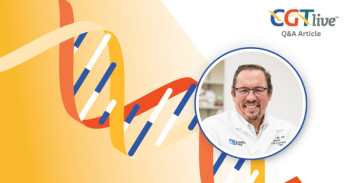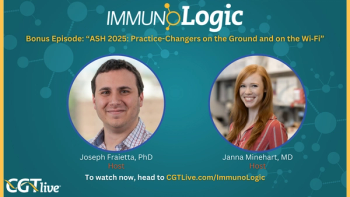
Bendamustine is an Effective Alternative to Flu/Cy for CAR-T
Uttam Rao, MD, MBA, a transplant physician at St. David's South Austin Medical Center of Sarah Cannon, discussed research comparing patient outcomes on different conditioning regimens for CAR-T.
All FDA-approved chimeric antigen receptor T-cell (CAR-T) therapies require a lymphodepleting chemotherapy conditioning regimen prior to administration. Traditionally, a regimen of fludarabine and cyclophosphamide (flu/cy) has been used for this purpose, but in the face of an international shortage of fludarabine, a Bendamustine-based conditioning regimen has been used by some treatment centers instead.
Uttam Rao, MD, MBA, a transplant physician at St. David's South Austin Medical Center of Sarah Cannon, has been studying whether the use of either conditioning regimen has an effect on patient outcomes for CAR-T treatment. Following a presentation of his network’s research at
CGTLive: Can you give some background information about your presentation?
Uttam Rao, MD, MBA: In essence, my talk was comparing Bendamustine versus flu/cy for lymphodepleting chemotherapy prior to CAR-T in lymphoma. In essence, fludarabine and cyclophosphamide are quite efficacious and have been used in all the registry trials so there’s a lot of experience with that. Although, an ongoing shortage of fludarabine internationally has made things difficult. While there are various mitigation strategies in place, it really forced us as a network to look for alternative options. In 2022, we [the Sarah Cannon network] shifted to Bendamustine from flu/cy. Given that we were doing this across the network, we had a lot of patients, so we decided to retrospectively analyze our outcomes so that we could give real world evidence on the efficacy of Bendamustine compared to flu/cy.
What were the key points you covered during your talk?
We had some interesting data. Firstly, the main goal of the study was to show if Bendamustine and flu/cy were equivalent, and largely that was the case. We saw equivalent overall survival at 1 year. One-year progression-free survival was also not different between groups.
But what was interesting was the severity of the cytopenias was greater with flu/cy. There were greater nadirs in lymphocyte counts with flu/cy compared to Bendamustine. This has been reported before. But what was unique about our study was that we were showing that also it impacted neutropenia. In other words, flu/cy caused worse neutropenia than Bendamustine. I think these are all important considerations, especially as CAR-T moves to the outpatient setting.
What are the big-picture implications that doctors and the healthcare community should take away from this?
I think the main takeaway is that Bendamustine is effective. It offers safe, effective lymphodepletion prior to CAR-T. Additionally, Bendamustine has certain operational advantages that make it easier to use than flu/cy: namely, the infusion is 10 minutes, and it's over 2 days, but for flu/cy, you have a 30 minute and a 60 minute infusion over 3 days. There are a lot of IV fluids and IV medications and that impacts how long somebody actually sits in the chair. If you're trying to have an effective, efficient program in the outpatient setting, it lends credence to the idea of a milder conditioning regimen.
Are there any areas of interest for future research in this space?
This was a retrospective analysis, looking at real-world patients, so it's useful. Although, the populations, even though they were well-matched, were not adjusted for various variables and stratified, like a proper randomized control trial would be. I think that would be ideal: a randomized control trial looking at Bendamustine versus flu/cy prior to CAR-T, and looking at long-term outcomes and having the controls in place. I think that would more effectively answer this question. Additionally, there’s the retrospective nature of this. We didn't have access to these data, but correlative studies using cytokine measurements to sort of help inform the picture would be useful adjunctive studies.
Is there anything else you want to add?
Our data showed no difference in overall clinical outcomes, looking at overall survival and progression-free survival between Bendamustine and flu/cy, but the data we reported was only to 1 year. An active question in the field is: “What is the progression-free survival after CAR-T and does that differ between conditioning regimens?” This is something that I hope to answer with our dataset. Essentially, with longer-term follow-up, we might be able to more effectively answer that question. At 1 year, the 2 groups were different. Maybe at 2 years or 5 years, that difference manifests itself. It definitely warrants additional study.
This transcript has been edited for clarity.
REFERENCES
1. Rao U, Blunk B, Bachier CR, et al. Bendamustine versus fludarabine and cyclophosphamide for lymphodepletion prior to CAR-T therapy. Presented at: 2024 Tandem Meetings, February 21-24, San Antonio, Texas. Abstract #70
Newsletter
Stay at the forefront of cutting-edge science with CGT—your direct line to expert insights, breakthrough data, and real-time coverage of the latest advancements in cell and gene therapy.





































